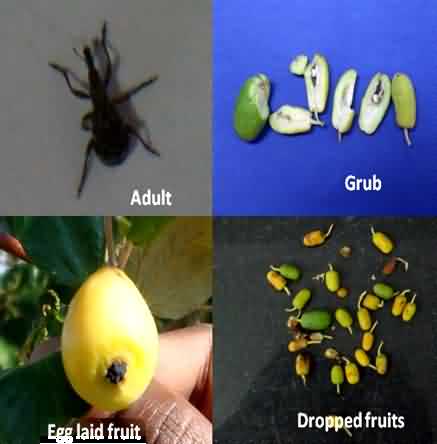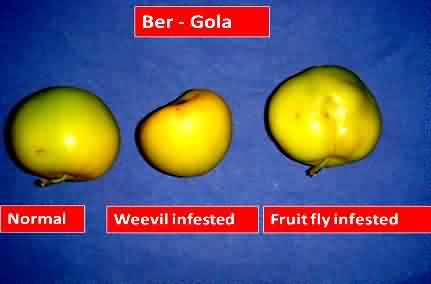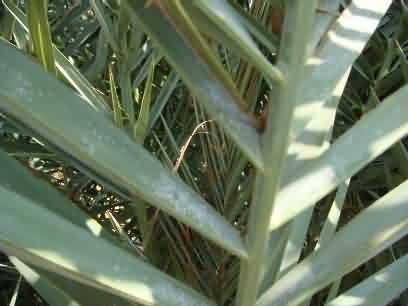शुष्क फलों के प्रचलित कीट-पतंग और उनके प्रबंधन के विकल्प
Remarkable increase in fruit crops cultivation under hot arid region of western India lead to drastic changes in the pest population dynamics. The fruits such as ber (Ziziphus mauritiana), date palm (Phoenix dactylifera) and bael (Aegle marmelos) are an important fruit crops grown in this area. The productivity is concern, it is low because of harsh environment (high temperature, low precipitation, high PET, high wind velocity), poor soil fertility and salinity. Beside these, the biotic pressure like pest and diseases also play a critical role, which cause significant loss and adds cost of production. Hence, in this article we discussed the present status of insect pests of these fruit trees and their management options and this information would be highly useful to the farmers of this region for successful management of different insect pests.
A. Insect pests of Ber
 1. Ber butter fly(Tarucus theophrastus Fab.)
1. Ber butter fly(Tarucus theophrastus Fab.)
Symptoms of damage:Larvae feed on sprouting tender shoots, leaves and flower buds. Infested leaves gives whitish look due to chlorophyll feeding finally the leaves remain with long streaks. It damages the leaves upto 25 to 40 per cent.
Period of activity: June to September
Recommendations: Spray of quinalphos (0.05%) during the sprouting and onset of flowering and repeat the spray at 15 days interval would give better control of this pest.
 2. Leaf webber (Synclera univocolis Walker)
2. Leaf webber (Synclera univocolis Walker)
Symptoms of damage:The newly hatched caterpillar attacks unopened and partially opened leaves and leaf folding with silken threads. The larvae consumes green matter by scrapping, leaving behind the papery epidermis. In severe state, the tree gives unhealthy appearance and stunted growth on growing point.
Period of activity: August to September
Recommendations: Application of quinalphos 2ml/liter or carbaryl 2g/liter during new vegetative flush and repeat the spray after 3 weeks found effective.
 3. Stone weevil (Aubeus himalayanus Voss)
3. Stone weevil (Aubeus himalayanus Voss)
Symptoms of damage: Black colour egg laid marking in the stylar end of fruits. Misshaping, fruit dropping immature ripening, shrinking due to endosperm damage and drying of fruits also the mark of infestation.
Period of activity: October to February
Recommendations: Spraying of carbaryl 50 WDP at 0.1% just before the fruit setting and repeat spays at three week interval.
4. Bark eating caterpillar (Indarbela sp)
Symptoms of damage: Presence of webs at angles weakening and cleavage of branches at fruit development stages. About 50 per cent of newly sprouted branches are infested by the caterpillar.
Period of activity: June to March
Recommendations: Removal of webbing at junction and injection of 0.05% dichlorvos using syringe would be effective.
 5. Fruit fly (Carpomyia vesuviana Costa)
5. Fruit fly (Carpomyia vesuviana Costa)
Symptoms of damage: Maggot starts feed on pulp and the infested fruits packed with excreta of maggot. Severe condition, fruits drop off.
Period of activity: November to February
Recommendations: Collection and destruction of infested fruits and soli digging during summer to expose the pupa to hot summer. Foliar application of NSKE 5 % followed by acephate 0.07% and repeat the NSKE 5 % as a third spray at 15 days interval.
B. Insect pests of Bael
 1. Swallowtail butterfly (Papilio demoleus Linn.)
1. Swallowtail butterfly (Papilio demoleus Linn.)
Symptoms of damage:The newly hatched larvae starts feed on lender leaves and later stages it damage the matured leaves also. Complete defoliation in the seedling stage of plants.
Period of activity: September to November
Recommendations: Hand collection and destruction of larvae andspray of dimethoate 2ml/liter would be effective.
 2. Peach fruit fly, (Bactrocera zonata) (Saunders):
2. Peach fruit fly, (Bactrocera zonata) (Saunders):
Symptoms of damage: The infested fruits drop off before mature. The fruit cracking and rotting also could observe in the infested fruits. After few days, active maggot comes out from the dropped fruit for pupation. About 40 to 50 larva has been observed from the single fruit. The infestation (fruit drop) will be more on late season cultivars.
Period of activity: February to April
Recommendations: Collection and destruction of dropped fruits and cracking of soil around the tree trunk to expose the pupa to hot sunlight during summer would give better control. Bait spray consist of (Malathion 50 gram + molasses 500 gram + 50 liter water) would give good control of adult population.
C. Insect pests of Date palm
1. Lesser date moth (Batrachedra amydraula Meyr)
Symptoms of damage:The larva starts the infestation at inflorescence stage, feeds on fruits and immature seeds severe case it leads fruits dropping.
Period of activity: February to September.
Recommendations: Spray schedule comprise of malathion 0.05% followed by deltamethrin would perform better against this pest.
 2. Scale (Parlatoria blanchardii Targ.)
2. Scale (Parlatoria blanchardii Targ.)
Symptoms of damage:The violet colour crawlers suck the sap on under surface of leaves, pinnules, main veins and fronts. Due to sap loss, it affects the vitality of tree fruit setting and development.
Period of activity: December to January.
Recommendations: Spray of dimethoate 2ml/liter and repeat the spray after 3 weeks.
3. Birds (bulbuls, sparrows, mynas, parrots, purple sunbird and crows)
Symptoms of damage:Yield loss up to 10 to 15 per cent. The “Doka “stage fruits are less preferred than “dang” and “pind” stage.
Period of activity: May to July.
Recommendations: Covering individual bunches with wire nets (3x3 mm) mesh after the thinning of bunches in a conical shape. Protecting of bunches with 600 gauge polythene cover at collar break stage also could avoid the bird damage.
Author:
V. Karuppaiah
Scientist (Agricultural Entomology)
Central Institute for Arid Horticulture
Beechwal, Bikaner-334006, Rajasthan
Email:
